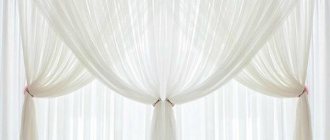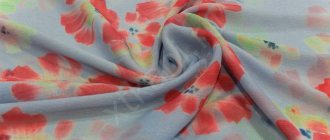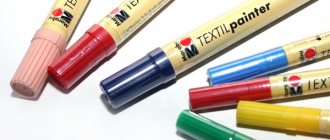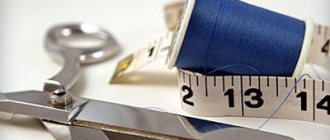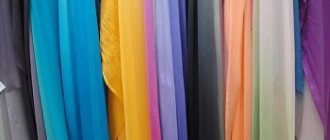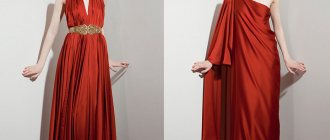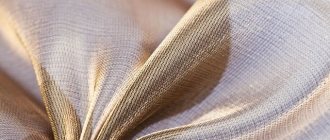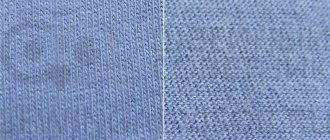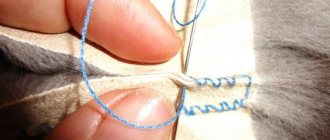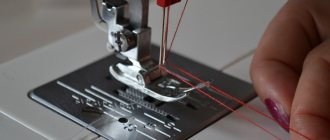Today we will show you how to cut so-called moving fabrics: thin, translucent and sliding. This is chiffon, cambric, all possible types of silk, and cotton too. We will show several options for preparing such fabrics for cutting.
To cut moving fabrics you will be helped by:
- regular or special scissors for cutting delicate fabrics;
- chalk, pencil, thermal marker,
- measuring tape, ruler;
- medical mask;
- choose the thinnest pins and needles;
- masking tape;
- weights, rulers;
- hairspray or starch in a tube.
Sewing seams on transparent fabrics
All transparent fabrics are very capricious in terms of finishing edge seams. In addition, the seams are visible on both sides, so special attention should be paid to their processing. Accordingly, the following seams are used when processing seams on transparent fabrics.
1. Simple seam
The parts are folded right sides together and the sections are ground down. The seam allowances are overlocked with an overlocker (2- or 3-thread), at the same time cutting off the seam allowances to a width of 0.5 cm or 0.75 cm. You can also overlock the seam allowances separately and iron them. The seams can also be finished on a sewing machine using a zigzag stitch. This stitch is laid at a distance of 0.75 cm from the seam, and then the excess allowances are cut off.
2. Covering seam
The cut pieces are folded right sides together and the edges are stitched down. Seam allowances are pressed to one side. The seam allowance lying below is cut to a width of 0.5 cm. The seam allowance lying on top is cut to a width of 1 cm, folded to a width of 0.5 cm and adjusted to the edge.
3. French or double seam
The cut pieces are folded wrong sides together and seam allowances are sewn to a width of 1 cm (= 0.5 cm from the marked seam line). The allowances are cut off at a distance of 0.5 cm from the completed seam and ironed. Then the parts are folded right sides together, so that the seam made runs exactly along the fold, and the stitching is laid at a distance of 0.5 cm from the fold exactly along the marked seam line, while the cut edges of the first seam are closed.
4. Topstitch stitch
The cut pieces are folded right sides together and the edges are stitched down. The seam allowances are cut to a width of 1 cm, ironed, folded to a width of 0.5 cm and adjusted to the edge.
Making darts on transparent fabrics Making tacks on a dart
At the top of the dart, do not tack or tie the ends of the threads, as they may be visible from the front side of the product. In this case, a clever tailoring trick will help: the top thread is removed from the sewing machine, and the bottom thread is threaded instead of the top thread in the opposite direction, starting from the needle, while the end of the thread located above the tension mechanism should be longer than the dart. The stitching starts from the top of the dart without a bartack. The seam will not diverge, since it is made with one thread.
Attention: stitching a dart from the top is not at all easy, so be sure to try this trick on a scrap piece first!
LiveInternetLiveInternet
It is appropriate to process some chiffon items with a “Moscow” seam: fold the edges of the blouse or sleeves 5 mm in two layers, having previously basted both hems. Remember, all seams must be done very carefully, otherwise the entire product will be hopelessly damaged.
MPFH advice: “Silk is different from silk. And yet, if you are just starting to sew, it is better to put aside natural silk until better times, when you get better at it. Go from simple to complex, and then sewing will give you pleasure.”
What to consider when choosing a model? Do not overload silk with details and complex cuts. It looks good when it falls freely, revealing all its beauty and plasticity. On transparent fabrics, a supate clasp and hanging loops look good.
Silk tends to come apart at the seams, so it is better to choose models with a loose fit. Is it possible to strengthen the seams? One method is a silk lining attached using the Hong Kong method. And what does the reverse side look like!
Only a lining or cover can ensure a beautiful fit for a silk dress with a fitted or semi-fitted silhouette. Interesting, multi-layered options can be achieved by using the same fabric for the “top and bottom”.
The lining, made in the standard way, is sewn separately, according to the same pattern as the dress, and is attached to the product “back to back”. It hides seams and darts on the inner surface, gives the product a professional look, and is recommended for NON-transparent fabrics.
The cover, unlike a regular lining, is sewn with the seams inside, and if the dress is made of transparent fabric, the allowances of the cover are visible from the outside much less than in the version with a lining. It can be sewn from lining fabric and attached to the top layer "face to back" or made as a separate dress, for example, with thin straps.
When choosing materials for the inner layer (including cushioning), approach it responsibly; the composition, density, and color will largely determine the impression you are counting on when creating an outfit.
Unfortunately, sweat can cause stains and make silk brittle. It is recommended to sew armpits to clothes made of silk! Does anyone use similar “details”?
Features of the cut. “Slippery” and plastic fabrics require more time for cutting, they are capricious when ironing. Some techniques will make your life easier - “Tricks, cutting, ironing.”
When starting to sew, let's pay attention to... Thin fabrics with a smooth surface are difficult to join without basting. You can seal the sections with a solution of gelatin or starch (if the fabric is light), applying it with a brush and ironing it through white paper.
“Slippery” and transparent fabrics are considered problematic, so you need to pay more attention to the “Choice of threads, needles...” before starting sewing. Be sure to experiment on pieces of fabric, fine-tuning your stitching. Make seams using a short stitch length (1.5-2 mm).
Cleanliness of processing when sewing transparent fabrics is very important. When choosing stitches for a particular fabric, try different ones. Sometimes when sewing an outfit it is worth using several varieties of them.
“Stitching seams and hem options” depend on the style of the dress: whether there are curved lines in the design of the model, whether the bottom should “flow” or whether it needs to be given a more rigid shape.
Attention! Do not sew across the pins as this may leave holes in the fabric. If the fabric is very delicate and the sewing machine feeder can damage it, place thin paper under the fabric when sewing.
Stitching direction (MPFH). Most sewing machines seat the bottom fabric. If you sew both halves of trousers from top to bottom, it will turn out that you will sew one leg along the front half, and the other leg along the back. With silk fabric, a light fit on the front half of one leg and a light fit on the back half of the other leg are clearly visible. Conduct an experiment on patches. If a problem exists, when sewing trousers, it is necessary to sew from top to bottom on one leg and from bottom to top on the other leg. In other products you need to follow the same rule.
Darts on transparent fabric. You should not tie the ends of the threads in a knot at the tops of the darts; this will be visible from the front side. This technique will help here: remove the top thread from the needle. Thread the lower thread instead of the upper thread in the opposite direction, that is, starting from the needle. The end of the thread located above the tension mechanism should be slightly longer than the dart. Start sewing the dart from the top without additional securing stitches. The seam will not diverge, as it is made with one thread.
Processing a set-in sleeve. It was discussed on the forum that when sewing from thin silk, even using a proven pattern, problems with the fit of the sleeve may arise. Fitting the sleeve cap is more difficult to do and looks less professional. The technique of “Attaching a sleeve using a knitted strip” will help you cope with trouble.
Attention to the neckline and armholes. In products made from light transparent fabrics, it is not advisable to process the neckline with hemming; the facing itself and seam allowances will be visible from the front side. “Treating the neck of a transparent outfit.” - it’s a delicate matter, forum users tell me.
MPFH (Marina) - about working with silk. Marina is a creative person. Due to her profession, she often has to deal with natural silk and light fabrics. When she shows her impressive works, questions arise - “how is it done?”, requests to share techniques. You will learn how to make a flawless seam and “maintain” the fit of a light blouse in “Finds” on working with silk from MPFH.
Airy, weightless, flirtatiously transparent chiffon has taken on the most romantic role on the fashion scene! And although “playing” with this “artist” is not difficult, you still cannot do without “rehearsals”!
Briefly ABOUT THE MAIN THINGS
The finest chiffon made from natural silk is one of the most expensive and noble materials. And it suits women amazingly!
The ideal option for the day is plain or printed chiffon with a floral pattern, for the evening - chiffon richly decorated with embroidery, sequins and beads.
Chiffon made from synthetic fibers costs much less and lasts much longer than luxurious but fragile silk fabric, while maintaining its characteristic grainy-delicate feel and airy lightness. The degree of transparency of chiffon depends on the density of the pattern.
With a gentle hand
OPEN
It is best to cut chiffon with a circular knife and on a special backing. If there is neither one nor the other, then place a backing under the chiffon that will not slip, for example a piece of linen, and cut the fabric with ordinary tailor's scissors.
Pin the paper pattern pieces only with thin pins with a perfect point, since any notch can damage the fabric.
Pattern pieces can also be glued on with thin strips of adhesive or spray adhesive. To do this, place the part on the fabric along the longitudinal/cross thread and place a weight in the middle. Raise the edges of the part, treat it with spray glue, let the glue set and press the edges of the part to the fabric.
Contours of parts (seam and bottom lines) and markings: you cannot transfer the contours and marking lines onto chiffon using carbon paper and a toothed wheel, since marks from the teeth will remain on the front side of the fabric and the lines will show through.
It is best to cut out all the parts with the same allowances, and then stitch the sections to the set width.
Dart, seam and fold lines can be marked using running stitches using a fine needle and thin thread.
Ironing: iron chiffon only dry - if it gets wet, the fabric may wrinkle. Make sure that the working surface of the iron is perfectly clean and without scratches, otherwise you will damage the fabric! If you don’t want to take risks, iron the chiffon through tissue paper (iron thermostat in position 1-2).
Interlining: for chiffon, a translucent woven interlining is ideal - interlining, which is ironed dry with a low-heat iron.
SEWING
Stitch chiffon cut pieces only with a fine needle (Microtexnadel) No. 60 or 70 and thin thread for machine embroidery (stitch length 1.5-2 mm).
When sewing, place tissue paper under the product to prevent the sewing machine feeder from damaging the fabric.
Overcast seam allowances especially carefully. An overlocker is ideal for this.
On a regular sewing machine, this is done like this: at a distance of 5 mm from the cut of the seam allowance, a zigzag stitch is laid, and then the allowance is cut close to it.
You can make a double (French) seam: fold the cut pieces with the wrong sides, sew the seam allowances along the middle line, press the seam allowances, and then fold the pieces right sides and stitch along the marked seam line. In this case, the cuts will be hidden inside, and the first seam will run exactly along the fold of the allowance.
CARE
Natural silk chiffon should be dry cleaned, while synthetic chiffon can be washed with mild detergents - by hand or in a washing machine on a gentle cycle.
ADVICE
To make the top of the dart almost invisible on chiffon, thread the bottom thread from the bobbin into the needle, pass it through as the top thread and start stitching at the top of the dart - this way you won’t need a bartack or a knot!
Caring for transparent fabric items
Organza and chiffon made from natural silk should be dry cleaned. Fabrics made from synthetic fibers can be washed with mild detergents in the washing machine on a gentle cycle or by hand. In this case, the products should not be rubbed or twisted, but only gently squeezed. Hang items to dry wet, without squeezing.
The cut details are sewn together with fine sewing threads or threads for machine embroidery and darning and a fine sewing machine needle No. 70 with a perfect point, preferably a needle for microfiber fabrics.
The seams are made by machine stitching with a small stitch (stitch length from 1.5 mm to 2 mm). Do not machine stitch over pins, as the thin fabric may tear. When basting, do not use thick basting threads, but thin sewing threads and a thin needle.
How to sew a dress from chiffon?
In recent years, a noticeable trend in fashion is the chiffon dress. It is present at the shows of many modern designers - Valentino, Givenchy, Versace. Sewing such a dress may not be very difficult if you follow the recommendations in this article.
Light chiffon dress
It can be sporty style in the form of a shirt dress with a through fastener or a polo strap. Or in the form of a romantic dress with ruffles and frills, with a flared skirt and a variety of wide sleeves. Also, a light dress can be a recently fashionable A-line silhouette (the extension comes from the chest line), which sends us back to the early 70s.
Chiffon dress pattern
For chiffon dresses, simple patterns are recommended, without a large number of hems and reliefs. On thin fabrics, it is advisable not to use mortise pockets (leaves, framed). Due to the properties of the fabric, its lightness and airiness, flying and flowing silhouettes and models are recommended. A bias cut may be recommended.
The shirt dress pattern is characterized by a straight silhouette, fairly wide sleeves with a cuff, and the presence of a fastener strap.
For a romantic look, the bodice can be based on a fairly tight-fitting line or a looser folk cut, with gathers at the neckline. Since such a dress is made cut off at the waist, the skirt can be of any silhouette: flared (sun, half-sun), straight with darts or gathered pleats at the waist.
A-line dresses, as a rule, are not cut-off, with a flare from the chest to the desired width of the bottom. Sometimes an undercut under the bust is allowed - this creates an empire-style dress.
Sleeves of dresses can be of various styles, including one-piece, sleeves widened at the bottom and sleeves like lanterns are welcome. Often in chiffon models, flounces, ruffles, frills are used for decoration - everything that allows you to show the beauty of the chiffon fabric.
Technology of working with chiffon
Chiffon is a light translucent plain weave fabric of varying degrees of density. The composition of raw materials for the production of this fabric is quite diverse: from natural silk to polyester synthetic fibers. But any chiffon is a fabric that is quite difficult to sew, as it is unstable, mobile, and slides when cutting and sewing seams.
In order to tame this unruly tissue, there are several methods of fixing it. This can be by pinning onto a stable fabric before cutting and cutting along with that fabric, or by pinning onto a thick woven backing (such as a blanket) and carefully cutting out the pieces above it. But the most convenient and simplest way of fixing is to treat the canvas with certain compounds.
Before starting work, the reverse side of the fabric is sprayed or sprayed with starching agent for ironing, strong hold hairspray or glue-based sizing. These additives make chiffon more rigid and stable. After drying and ironing (if necessary), you can work with the material.
The main requirement for such processing of fabric is that it should not leave stains and should be easy to rinse when sewing is completed.
We sew from chiffon
After cutting and trying on the chosen model, you can begin sewing the dress. As a rule, chiffon can be easily sewn with a regular stitch on any household sewing machine if the needles and threads are selected correctly.
Thin fabric requires thin needles (No. 70,80) and threads (50 denier or more). The stitch pitch is set quite small.
If gaps occur in the seam, you can use paper sewing - strips of thin paper (tracing paper, for example) are placed under the presser foot, along which the stitching runs. Then the paper is torn off.
The seams used to make chiffon products can be ordinary - with open cuts and further processing of the edges with an overlocker. And they can also have closed cuts: a linen seam or a French seam.
Overlay seams are used less frequently (one layer of fabric is simply placed on top of another) - in this case, the edge of the fabric becomes fringed during wear and creates a fringe.
Most often, such seams are used in products cut on the bias (at an angle of 45º to the grain thread).
Finishing seams along the bottom of the dress and sleeves can also be different: from a rolled seam on an overlock, which produces a satin roll along the cut, to simply tearing off a strip along the bottom, when the edge of the hem is not processed in any way.
To secure this edge treatment, a stabilizing straight stitch may be required 0.3-0.5 mm from the edge. Also, a certain decorative effect on the processing of the bottom of the product can be given by stretching the fabric with a rolled seam (you get a ruffle) or sewing a fishing line along the bottom of the dress with a zig-zag seam.
The Moscow seam (double straight stitch) can also be used to process the bottom.
Necklines and armholes on dresses are easiest to handle with double bias tape made from the dress fabric. Moreover, it can turn away both to the inside and to the face of the product. Sometimes it is more convenient to cut the double bodice so that all the seams go inward between the two parts.
To stabilize individual parts: collars, cuffs, trims, waistbands, thin adhesive pads, translucent and matching in color, are used. If the use of adhesive pads is impossible (they stand out, are noticeable), organza of a suitable color can be used for rigidity, which is sewn inside the part.
Inexpensive chiffon
All of the above regarding processing applies to chiffons made from any type of fiber. As a rule, any natural raw material (silk, viscose, acetate) can be made cheaper by adding synthetics - polyester, nylon, lavsan. The convenience of such textiles is extended service life, easy to care for, does not require ironing, and dries quickly.
Chiffon plain
Well suited for summer office shirt dresses worn with tops, skirts or trousers. Another winning option: a chazuble dress with high slits in the side seams, which can be worn with a top and skinny trousers.
Chiffon with print
Recently, photos and 3D prints on chiffon fabrics have come into fashion. As a rule, such rich designs look good on evening dresses, party dresses and beach tunic dresses. But the classic floral ornament, from large to small floral motifs, has not been forgotten. The latter are simply irreplaceable in boho style and romantic dresses for young girls.
Source: https://www.tkani-textiliya.ru/shjem-platje-iz-shifona
Fabrics with elastic threads
These fabrics both stretch perfectly and hold their shape well due to the inclusion of elastic threads (elastane) in their composition, along with natural and synthetic fibers. These fabrics can stretch either transversely or longitudinally, or in both directions simultaneously. If the fabric stretches only in one direction, then the parts must be cut so that they stretch across.
Depending on the quality, elastic fabrics can shrink up to 5-10% when washed and ironed; we always take this possibility into account when calculating fabric consumption. Before cutting, be sure to iron the fabric with an iron with a humidifier or through a damp iron. Or wash the fabric if the care instructions allow it.
To sew cut parts from elastic fabrics, use a special needle. To ensure that the seams of the product remain elastic, the sections of the parts are stitched with a narrow zigzag stitch (stitch width is 0.5-1 mm, stitch length - 3-4 mm) or a special elastic stitch (see the instructions for your sewing machine). The hem of the bottom is adjusted with a double needle of a sewing machine, which gives 2 parallel straight lines on the front side of the product, and a zigzag stitch on the wrong side. Also monitor the thread tension in the sewing machine - it should not be too tight.
Mixed fabrics made from cotton, linen, viscose, synthetic fibers and elastane can be washed, but very carefully and using mild detergents. The temperature of the water depends on what fibers the elastane is mixed with. Elastic cotton fabrics are washed at a water temperature of 60°C, and in other cases the water temperature should not exceed 30-40°C.
Iron elastic fabrics with a low or moderately heated iron, having first tried it on an unnecessary flap.
Characteristics of crepe chiffon
Properties
Crepe chiffon combines the properties of two fabrics: chiffon, which is airy and light, and crepe with the peculiarities of weaving threads inside the material. The structure of the material is fine-grained and has one unique feature - it has a specific interweaving of threads in different directions.
The thread itself in the fabric is twisted as much as possible, which gives the material special strength and unusual texture. Even an inexperienced person can identify crepe by touch by its grainy and dense surface.
This structure characterizes the high quality of products made from this fabric and guarantees the quality of clothing, the seams in the products do not deform or unravel , and the product does not lose strength over time.
Due to the plain weave structure of the threads, the material does not have a front or back side , which is very convenient for cutting various variants of models; here you can use draperies with different flying panels, single-layer flounces, and unusual collars of complex cut; they do not require double parts . and the fabric will turn out to be economical in sewing.
It is best to use silk as a raw material. Then the material will turn out to be exquisite and expensive, and will give lightness and coolness even in the summer heat. In Eastern countries, a special abaya silk fabric is used to make a traditional national women's outfit, which is comfortable in high temperatures in summer. This fabric “breathes” and is highly hygroscopic.
